t’s hard to believe we are already into January of 1999, the last year of this century. It’s amazing to consider how the recycling industry has evolved over the past 99 years. At the turn of this century, the industry consisted of rag collectors and junk dealers collecting scrap for remanufacturing. Nobody considered it recycling, or even an industry. It was simply a way to make a living and a cost-effective, necessary source of raw materials. Today the scrap and recycling industry is an advanced raw materials manufacturing business. It applies some of the most sophisticated technology available to man to handle, sort, process and purify millions of tons of secondary materials from iron and steel to nonferrous metals, paper and advanced polymers.
As the industry has advanced so, too, has Recycling Today magazine. 1999 will see us roll out a number of new advancements. One of the most interesting will be the introduction of market updates at the beginning of the Ferrous, Nonferrous and Paper departments (by the way, paper will have its own department in 1999). These updates will cover the market movement for that respective commodity over the past month. We’ll look at supply and demand issues, market influences, pricing and other factors affecting commodity movement and pricing. We’ll also continue our exclusive series of Commodity Supplements and Equipment Guides. We’ll produce our Ferrous Supplement in January, Nonferrous Supplement in August and Paper Supplement in October. Equipment Guides will include our Baler Guide in February, an all new Separation Equipment Guide in May, the Scrap Handler Guide in June, Shredder Guide in July and Material Handling Equipment Guide in November. And, finally, we’re retitling our Installations department to Equipment Report. This change will allow us to enhance our coverage of equipment and supplier related news of interest to you.
Over the past 99 years the industry has seen many ups and downs in commodity pricing and movement. As scrap dealers and recyclers wind their way through the current difficult markets, having access to the best and most current market information and processing technology—to achieve the lowest possible operating costs —will increasingly prove critical. Recycling Today is committed to delivering that level of business information. Our 1999 Editorial Calendar is packed with features on commodity markets, business issues, legislative affairs, products and more.
We hope you enjoy the enhancements we are introducing in 1999 and that they will add value and enjoyment to the time you spend with Recycling Today each month. Let us know how we are doing by sharing your comments and thoughts with us via e-mail, fax or letter.
As I have said before in this column, reporting on what is happening in the recycling business on a global basis is the easy part of our job. However, to fulfill our mission we must always provide authoritative and bold reporting that is broad-based and that anticipates and analyzes developments most important to our readers’ business interests. That requires seeing beyond what is in front of us and looking into the future. That’s the tough job, but it’s one we are committed to now, and will be committed to in the next century.
Best of luck in the year ahead!
Sponsored Content
Labor that Works
With 25 years of experience, Leadpoint delivers cost-effective workforce solutions tailored to your needs. We handle the recruiting, hiring, training, and onboarding to deliver stable, productive, and safety-focused teams. Our commitment to safety and quality ensures peace of mind with a reliable workforce that helps you achieve your goals.
Get curated news on YOUR industry.
Enter your email to receive our newsletters.

Explore the July 2001 Issue
Check out more from this issue and find your next story to read.
Latest from Recycling Today
- Steel Dynamics cites favorable conditions in Q1
- Hydro starts up construction in Spain
- Green Cubes unveils forklift battery line
- Rebar association points to trade turmoil
- LumiCup offers single-use plastic alternative
- European project yields recycled-content ABS
- ICM to host colocated events in Shanghai
- Astera runs into NIMBY concerns in Colorado







